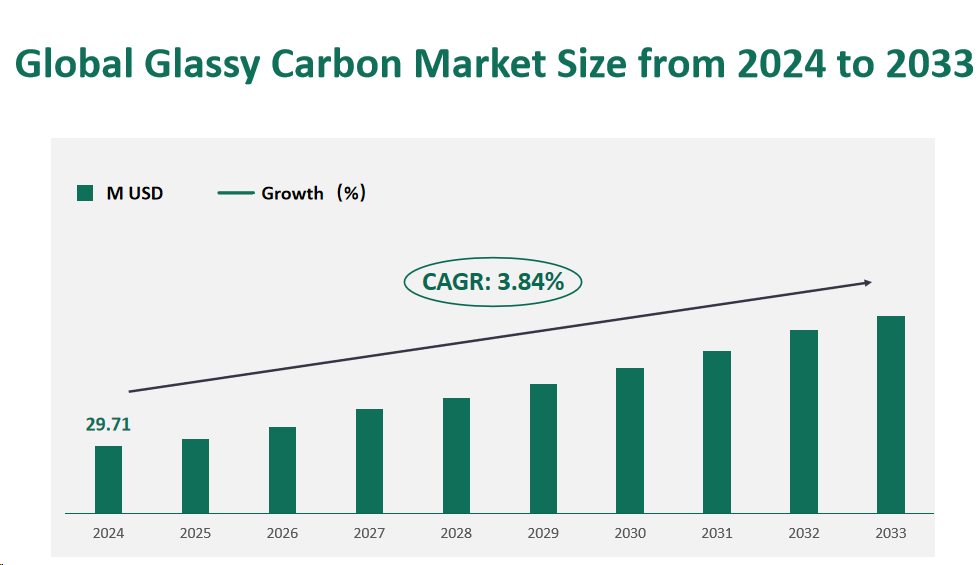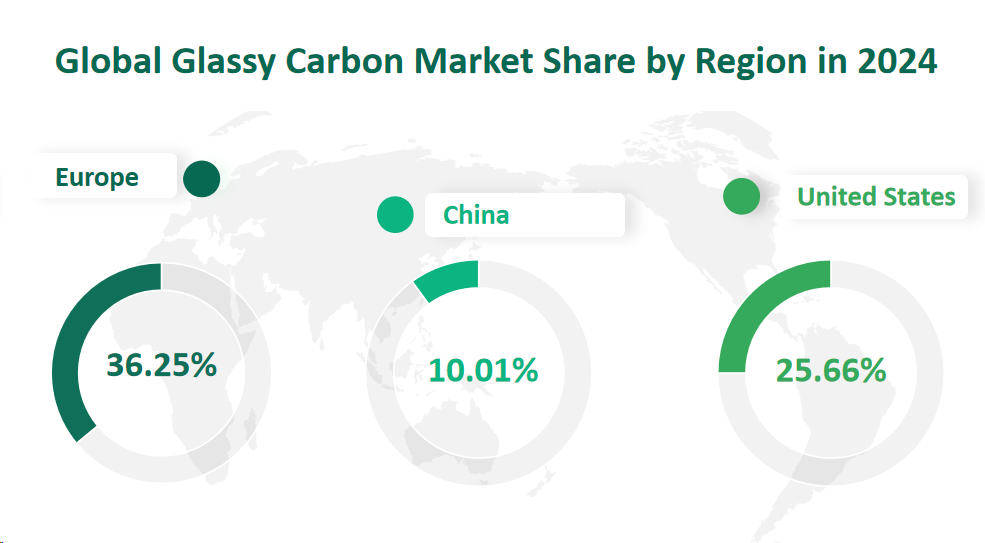1 Global Glassy Carbon Market Size (Value) and CAGR (2024-2033)
The global Glassy Carbon market is projected to generate significant revenue in 2024, with total expected earnings of 29.71 million USD. This market is anticipated to grow at a Compound Annual Growth Rate (CAGR) of 3.84% from 2024 to 2033.
Glassy Carbon, also known as vitreous carbon, is a unique material characterized by its glass-like structure and properties. It is derived from the pyrolysis of organic polymers, resulting in a product that exhibits low electrical resistance, high-temperature stability, and excellent chemical inertness. These properties make Glassy Carbon suitable for a variety of applications, including electrochemical sensors, high-temperature crucibles, and components in semiconductor manufacturing.
Figure Global Glassy Carbon Market Size (M USD) and CAGR 2024-2033

2 Drivers and Challenges of the Glassy Carbon Market Growth
The growth of the Glassy Carbon market is driven by several key factors. First, the increasing demand for advanced materials in industries such as electronics, aerospace, and biomedical applications is propelling market expansion. Glassy Carbon’s unique properties, such as its high thermal resistance and chemical stability, make it ideal for use in harsh environments, which is particularly valuable in the semiconductor industry.
Additionally, the rise in research and development activities aimed at exploring new applications for Glassy Carbon, such as in drug delivery systems and dental implants, further fuels market growth.
However, the Glassy Carbon market also faces several challenges. One significant challenge is the fluctuation in raw material prices, which can impact production costs and profit margins. The production of Glassy Carbon requires high temperatures and specialized processes, leading to high manufacturing costs. This can limit the accessibility of Glassy Carbon products to smaller companies or emerging markets.
Furthermore, the market is characterized by a high level of competition among established players, which can lead to price wars and reduced profitability. Companies must continuously innovate and improve their production processes to maintain a competitive edge, which requires substantial investment in research and development.
3 Technological Trends and Mergers in the Glassy Carbon Market
The technological landscape of the Glassy Carbon market is evolving rapidly, with ongoing advancements in production techniques and material applications. Innovations in synthesis methods are enhancing the quality and performance of Glassy Carbon products, making them more suitable for a wider range of applications. For instance, the development of new processing techniques allows for the creation of Glassy Carbon materials with tailored properties, such as improved electrical conductivity and mechanical strength.
In terms of market consolidation, mergers and acquisitions are becoming increasingly common as companies seek to enhance their capabilities and expand their market reach. A notable example is NEYCO’s integration into the French industrial group HEF, which aims to leverage synergies in research and development to advance Glassy Carbon technology.
4 Global Glassy Carbon Market Size and Share by Type in 2024
The global Glassy Carbon market can be segmented into two primary types based on service temperature: below 1100°C and above 2000°C.
Service Temperature Below 1100°C: This segment is primarily used in applications such as electrochemical sensors and laboratory equipment. Its projected revenue in 2024 is 8.92 million USD, with a CAGR of 3.43% from 2024 to 2033.
Service Temperature Above 2000°C: This segment is crucial for high-performance applications, including aerospace components and high-temperature crucibles. It is projected to reach 20.79 million USD in revenue in 2024, with a CAGR of 4.03% from 2024 to 2033.
Table Global Glassy Carbon Market Size and Share by Type in 2024
Type | Market Size (M USD) 2024 | Market Share 2024 |
Service Temperature Below 1100°C | 8.92 | 30.02% |
Service Temperature Above 2000°C | 20.79 | 69.98% |
5 Global Glassy Carbon Market Size and Share by Application in 2024
The global Glassy Carbon market is segmented into various applications, each with its unique market size and growth prospects for 2024.
Glassy Carbon Crucibles are expected to dominate the market with a projected revenue of 14.74 million USD in 2024, holding a significant share of 49.60%. These crucibles are essential in laboratories for the preparation of fluorophosphates and other glassy substances, particularly in chemical analyses and single crystal growth.
Glassy Carbon Plates are anticipated to generate 1.91 million USD. Their applications range from casting and smelting of metals to use in high-temperature crucibles and prosthetic devices.
Glassy Carbon Rods are projected to reach 8.14 million USD. These rods are used in various high-temperature applications and as electrode materials in electrochemistry.
Glassy Carbon Disks are estimated to contribute 1.75 million USD, with a 5.89% share. They are used in applications requiring high purity and strength, such as in semiconductor processing and high-temperature experiments.
Table Global Glassy Carbon Market Size and Share by Application in 2024
Application | Market Size (M USD) 2024 | Market Share 2024 |
Glassy Carbon Crucibles | 14.74 | 49.60% |
Glassy Carbon Plate | 1.91 | 6.44% |
Glassy Carbon Rods | 8.14 | 27.40% |
Glassy Carbon Disks | 1.75 | 5.89% |
Others | 3.17 | 10.68% |
6 Global Glassy Carbon Market Size and Share by Region in 2024
The global Glassy Carbon market is characterized by a diverse geographical distribution, with Europe, the United States, China, and Japan emerging as key regions contributing significantly to the market’s growth and development. Each region presents unique dynamics that influence the market’s trajectory.
Europe is projected to maintain the largest market share in 2024, with an anticipated revenue of 10.77 million USD, accounting for 36.25% of the global market. Europe’s dominance can be attributed to its well-established industrial base, which are heavy users of Glassy Carbon products. The region’s commitment to technological advancement and strict environmental regulations has fostered an environment conducive to the growth of the Glassy Carbon market.
The United States is expected to contribute significantly to the global Glassy Carbon market, with a projected revenue of 7.62 million USD in 2024. The U.S. market is driven by the country’s strong presence in the aerospace, automotive, and electronics industries, which demand high-performance materials like Glassy Carbon. The market in the U.S. is also supported by a robust manufacturing infrastructure and a consistent demand for advanced materials in research and development.
China is anticipated to have a substantial market share, with an estimated revenue of 2.98 million USD in 2024, representing 10.01% of the global market. The rapid industrialization and the growing demand for advanced materials in the electronics and chemical industries are key factors driving the market in China. The country’s focus on expanding its high-tech sectors and its investment in research and development are expected to further stimulate the market for Glassy Carbon.
Japan’s market for Glassy Carbon is expected to generate 2.41 million USD in 2024. Japan’s market is influenced by the country’s advanced technology sector and its strong presence in the automotive and electronics industries. The market in Japan is characterized by a high demand for precision and quality, which Glassy Carbon products fulfill.
Figure Global Glassy Carbon Market Share by Region in 2024

7 Top Companies in the Global Glassy Carbon Market
7.1 Tokai Carbon
Tokai Carbon, established in 1918, is a comprehensive manufacturer of carbon and graphite products with a strong presence in North America, Europe, and Asia. The company offers a wide range of high-purity Glassy Carbon products for the semiconductor, electrical, mechanical, and chemical analysis industries.
They provide graphite electrodes for electric furnaces, carbon black varieties for tire reinforcement and pigments, and fine carbon products like isotropic graphite and C/C composites. Tokai Carbon also caters to the silicon semiconductor, solar cell manufacturing, and other high-temperature applications with their furnace materials.
In 2024, Tokai Carbon achieved a revenue of 13.26 million USD and a gross margin of 33.60%.
7.2 HTW Hochtemperatur-Werkstoffe
Founded in 1989, HTW Hochtemperatur-Werkstoffe operates primarily in Germany and sells worldwide and is a leading manufacturer of glassy carbon products.
They offer a comprehensive range of glassy carbon products, including plates, rods, and tubes, which are used in various industries due to their exceptional thermal and chemical properties. The company is recognized for its SIGRADUR® G glassy carbon plates, which are available in various thicknesses and sizes.
In 2024, HTW Hochtemperatur-Werkstoffe recorded a revenue of 8.57 million USD and a gross margin of 30.21%.
7.3 NEYCO
NEYCO, established in 1954, is based in France and primarily serves the European market. The company provides glassy Carbon in various forms, including substrates, foils, or films. Their product offerings focus on glassy Carbon materials that are tailored to customer specifications, catering to the needs of vacuum and ultra-high vacuum applications.
They also offer a diverse range of products, including evaporation materials, deposit systems, filaments, and electron guns. NEYCO’s expertise in thin film materials and vacuum technology has been further enhanced by its integration into the French industrial group HEF, which has broadened its capabilities and market reach.
In 2024, NEYCO generated a revenue of 0.78 million USD and achieved a gross margin of 33.87%.





